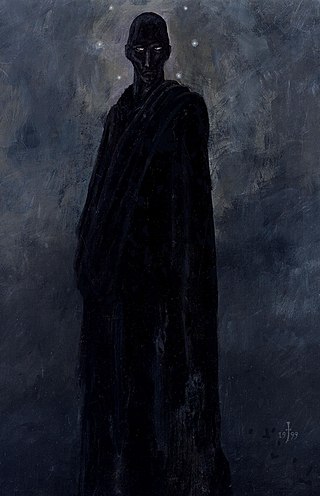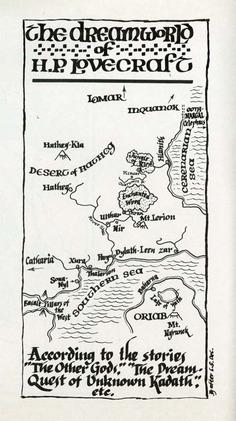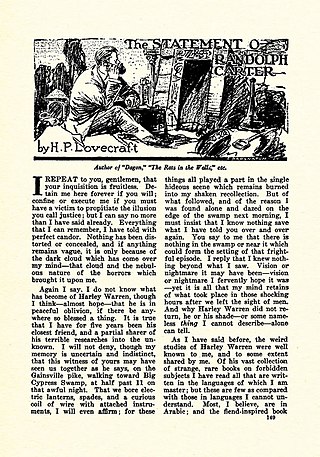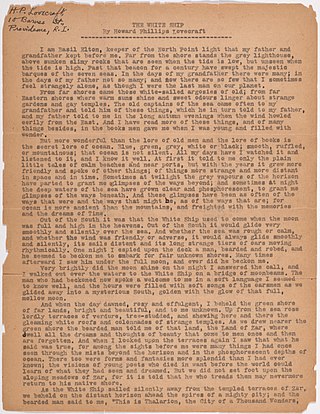
Nyarlathotep is a fictional character created by H. P. Lovecraft. The character is a malign deity in the Cthulhu Mythos, a shared universe. First appearing in Lovecraft's 1920 prose poem "Nyarlathotep", he was later mentioned in other works by Lovecraft and by other writers, to the point of often being considered the main antagonist of the Cthulhu Mythos as a whole. He is presented as the messenger of Azathoth. He is later described by other authors as being part of the Other Gods, an alien pantheon.

Azathoth is a deity in the Cthulhu Mythos and Dream Cycle stories of writer H. P. Lovecraft and other authors. He is the supreme deity of the Cthulhu Mythos and the ruler of the Outer Gods, and may also be seen as a symbol for primordial chaos, therefore being the most powerful entity in the entirety of the Cthulhu Mythos.

"The Cats of Ulthar" is a short story written by American fantasy author H. P. Lovecraft in June 1920. In the tale, an unnamed narrator relates the story of how a law forbidding the killing of cats came to be in a town called Ulthar. As the narrative goes, the city is home to an old couple who enjoy capturing and killing the townspeople's cats. When a caravan of wanderers passes through the city, the kitten of an orphan (Menes) traveling with the band disappears. Upon hearing of the couple's violent acts towards cats, Menes invokes a prayer before leaving town that causes the local felines to swarm the cat-killers' house and devour them. Upon witnessing the result, the local politicians pass a law forbidding the killing of cats.

At the Mountains of Madness is a science-fiction horror novella by the American author H. P. Lovecraft, written in February/March 1931. Rejected that year by Weird Tales editor Farnsworth Wright on the grounds of its length, it was originally serialized in the February, March, and April 1936 issues of Astounding Stories. It has been reproduced in numerous collections.

The Dream Cycle is a series of short stories and novellas by author H. P. Lovecraft (1890–1937). Written between 1918 and 1932, they are about the "Dreamlands", a vast alternate dimension that can only be entered via dreams. The Dreamlands are described as lying deeper than space, matter and time, and are a "limitless vacua beyond all thought and entity".

Randolph Carter is a recurring fictional character created by H. P. Lovecraft. The character first appears in "The Statement of Randolph Carter", a short story Lovecraft wrote in 1919 based on one of his dreams. An American magazine called The Vagrant published the story in May 1920. Carter appears in seven stories written or co-written by Lovecraft, and has since appeared in stories by other authors.

The Dream-Quest of Unknown Kadath is a Horror novella by American writer H. P. Lovecraft. Begun probably in the autumn of 1926, the draft was completed on January 22, 1927 and it remained unrevised and unpublished in his lifetime. It is both the longest of the stories that make up his Dream Cycle and the longest Lovecraft work to feature protagonist Randolph Carter. Along with his 1927 novel The Case of Charles Dexter Ward, it can be considered one of the significant achievements of that period of Lovecraft's writing. The Dream-Quest combines elements of horror and fantasy into an epic tale that illustrates the scope and wonder of humankind's ability to dream.

"Celephaïs" is a fantasy story by American horror fiction writer H. P. Lovecraft, written in early November 1920 and first published in the May 1922 issue of the Rainbow. It is part of the body of work which later came to be known as Lovecraft's Dream Cycle. The title refers to a fictional city that later appears in other Dream Cycle stories, including Lovecraft's novella The Dream-Quest of Unknown Kadath (1926).

"Pickman's Model" is a short story by H. P. Lovecraft, written in September 1926 and first published in the October 1927 issue of Weird Tales.

"The Statement of Randolph Carter" is a short story by American writer H. P. Lovecraft. Written in December 1919, it was first published in The Vagrant, May 1920. It tells of a traumatic event in the life of Randolph Carter, a student of the occult loosely representing Lovecraft himself. It is the first story in which Carter appears. Its adaptations include the film The Unnamable II: The Statement of Randolph Carter.

"The White Ship" is a horror short story by American writer H. P. Lovecraft. It was first published in The United Amateur #2, November 1919, and later appeared in the March 1927 issue of Weird Tales.

"The Rats in the Walls" is a short story by American author H. P. Lovecraft. Written in August–September 1923, it was first published in Weird Tales, March 1924.

"The Strange High House in the Mist" is a short story by H. P. Lovecraft. Written on November 9, 1926, it was first published in the October 1931 issue of Weird Tales. It concerns a character traveling to the titular house which is perched on the top of a cliff which seems inaccessible both by land and sea, yet is apparently inhabited.

"The Silver Key" is a fantasy short story by American writer H. P. Lovecraft. Written in 1926, it is considered part of his Dreamlands series. It was first published in the January 1929 issue of Weird Tales. It is a continuation of "The Dream-Quest of Unknown Kadath", and was followed by a sequel, "Through the Gates of the Silver Key", co-written with E. Hoffmann Price. The story and its sequel both feature Lovecraft's recurring character of Randolph Carter as the protagonist.

At the Mountains of Madness and Other Novels is a collection of stories by American author H. P. Lovecraft. It was originally published in 1964 by Arkham House in an edition of 3,552 copies. The true first edition has no head- or tailbands and features a green dustjacket.

The Doom That Came to Sarnath and Other Stories is a collection of fantasy and horror stories by H. P. Lovecraft, edited by Lin Carter. It was first published in paperback by Ballantine Books as the twenty-sixth volume of its Ballantine Adult Fantasy series in February 1971. It was the second collection of Lovecraft's works assembled by Carter for the series, the first being The Dream-Quest of Unknown Kadath. The stories were written between 1919 and 1935, and originally published in various fantasy magazines, notably Weird Tales.

The Dreams in the Witch House and Other Weird Stories is Penguin Classics' third omnibus edition of works by 20th-century American author H. P. Lovecraft. It was released in September 2004 and is still in print.

Necronomicon: The Best Weird Tales of H.P. Lovecraft: Commemorative Edition is a select collection of horror short stories, novellas and novels written by H. P. Lovecraft. The book was published in 2008 by Gollancz and is edited by Stephen Jones.

Cthulhu Mythos deities are a group of fictional deities created by American author H. P. Lovecraft (1890–1937), and later expanded by others in the fictional universe known as the Cthulhu mythos.


















